Java - ThreadPoolExecutor
ThreadPoolExecutor
在java.uitl.concurrent.ThreadPoolExecutor類是Executor框架中最核心的類。
先來看頂部注釋:

Ref: 线程池你真不来了解一下吗? - Java3y - 博客园
構造方法與參數說明
ThreadPoolExecutor有四個構造方法,前三個都是基於第四個實現。
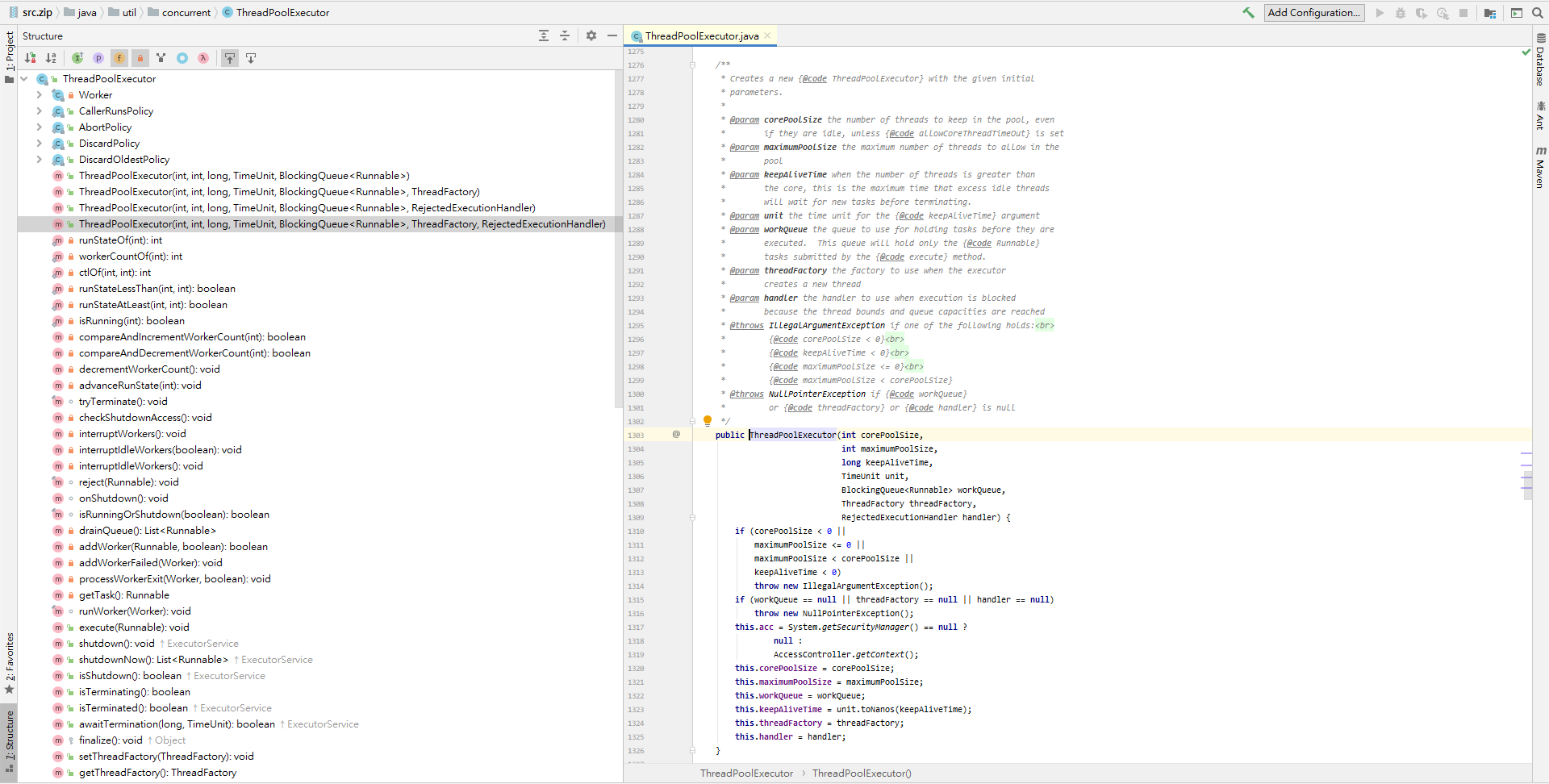
第四個構造方法定義如下:
七個參數重點:
- 指定核心線程數量
- 指定最大線程數量
- 允許線程空閒時間
- 時間對象
- 阻塞列隊
- 線程工廠
- 任務拒絕策略
/**
* 用给定的初始参数创建一个新的ThreadPoolExecutor。
* @param keepAliveTime 当线程池中的线程数量大于corePoolSize的时候,如果这时没有新的任务提交,
* 核心线程外的线程不会立即销毁,而是会等待,直到等待的时间超过了keepAliveTime;
* @param unit keepAliveTime参数的时间单位
* @param workQueue 等待队列,当任务提交时,如果线程池中的线程数量大于等于corePoolSize的时候,把该任务封装成一个Worker对象放入等待队列;
*
* @param threadFactory 执行者创建新线程时使用的工厂
* @param handler RejectedExecutionHandler类型的变量,表示线程池的饱和策略。
* 如果阻塞队列满了并且没有空闲的线程,这时如果继续提交任务,就需要采取一种策略处理该任务。
* 线程池提供了4种策略:
1.AbortPolicy:直接抛出异常,这是默认策略;
2.CallerRunsPolicy:用调用者所在的线程来执行任务;
3.DiscardOldestPolicy:丢弃阻塞队列中靠最前的任务,并执行当前任务;
4.DiscardPolicy:直接丢弃任务;
*/
public ThreadPoolExecutor(int corePoolSize,
int maximumPoolSize,
long keepAliveTime,
TimeUnit unit,
BlockingQueue<Runnable> workQueue,
ThreadFactory threadFactory,
RejectedExecutionHandler handler) {
if (corePoolSize < 0 ||
maximumPoolSize <= 0 ||
maximumPoolSize < corePoolSize ||
keepAliveTime < 0)
throw new IllegalArgumentException();
if (workQueue == null || threadFactory == null || handler == null)
throw new NullPointerException();
this.corePoolSize = corePoolSize;
this.maximumPoolSize = maximumPoolSize;
this.workQueue = workQueue;
this.keepAliveTime = unit.toNanos(keepAliveTime);
this.threadFactory = threadFactory;
this.handler = handler;
}
【參數說明】:
corePoolSize: 線程池的基本線程數。這個參數跟後面講述的線程池的實現原理有非常大的關係。在創建了線程池後,默認情況下, 線程池中並沒有任何線程,而是等待有任務到來才創建線程去執行任務,除非調用了prestartAllCoreThreads()或者prestartCoreThread()方法, 從這兩個方法的名字就可以看出,是預創建線程的意思,即在沒有任務到來之前就創建corePoolSize個線程或者一個線程。默認情況下, 在創建了線程池後,線程池中的線程數為0,當有任務來之後,就會創建一個線程去執行任務,當線程池中的線程數目達到corePoolSize後, 就會把到達的任務放到緩存列隊當中。maximumPoolSize: 線程池允許創建的最大線程數。如果列隊滿了,並且已創建的線程數小於最大線程數,則線程池會再創建新的線程執行任務。 值得注意的是如果使用了無界的任務列隊,這個參數就沒什麼效果。keepAliveTime: 線程活動保持時間。線程池的工作線程空閒後,保持存活的時間,所以如果任務很多,並且每個任務執行時間比較短,可以調大這個時間,提高線程的利用率。unit: 參數keepAliveTime的時間單位,有七種取值。- DAYS
- HOURS
- MINUTES
- MILLISECONDS
- MICROSECONDS
- NANOSECONDS
workQueue: 任務列隊。用於保存等待執行的任務的阻塞列隊,可以選擇以下幾個阻塞列隊:ArrayBlockingQueue: 是一個基於數組結構的有界阻塞列隊,此列隊按FIFO(先進先出)原則對元素進行排序。LinkedBlockingQueue: 一個基於鏈表結果的阻塞列隊,此列隊按照FIFO(先進先出)排序元素,吞吐量通常高於ArrayBlockingQueue。 靜態工廠方法Executors.newFixedThreadPool()使用了這個列隊。SynchronousQueue: 一個不儲存元素的阻塞列隊。每個插入操作必須等到另一個線程調用移除操作,否則插入操作一直處於阻塞狀態。吞吐量通常要高於LinkedBlockingQueue。 靜態工廠方法Executors.newCachedThreadPool使用了這個列隊。PriorityBlockingQueue: 一個具有優先級的無限阻塞列隊。
threadFactory: 創建線程的工廠。可以通過線程工廠給每個創建出來的線程設置更有意義的名字。handler: 飽和策略。當列隊和線程都滿了,說明線程池處於飽和狀態,那麼必須採取一種策略處理移交的新任務。這個策略默認情況下是AbortPolicy,表示無法處理新任務時拋出異常。 以下是JDK1.5提供的四種策略:AbortPolicy: 直接拋出異常。CallerRunsPolicy: 只用調用者所在線程來運行任務。DiscardOldestPolicy: 不處理,丟棄掉。- 當然也可以根據應用場景需求來實現
RejectedExecutionHandler接口自定義策略。如記錄日誌或持久化不能處理的任務。
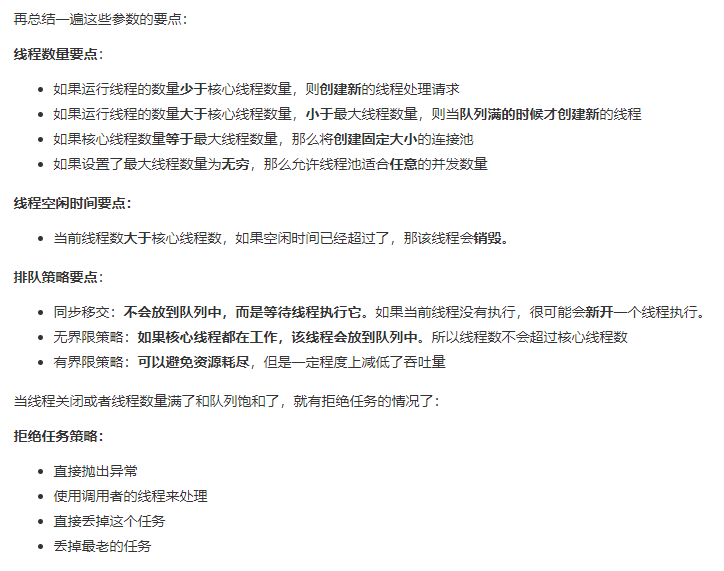
Ref:
線程池狀態
線程池的5種狀態:Running、ShutDown、Stop、Tidying、Terminated

变量ctl定义为AtomicInteger,记录了“线程池中的任务数量”和“线程池的状态”两个信息。
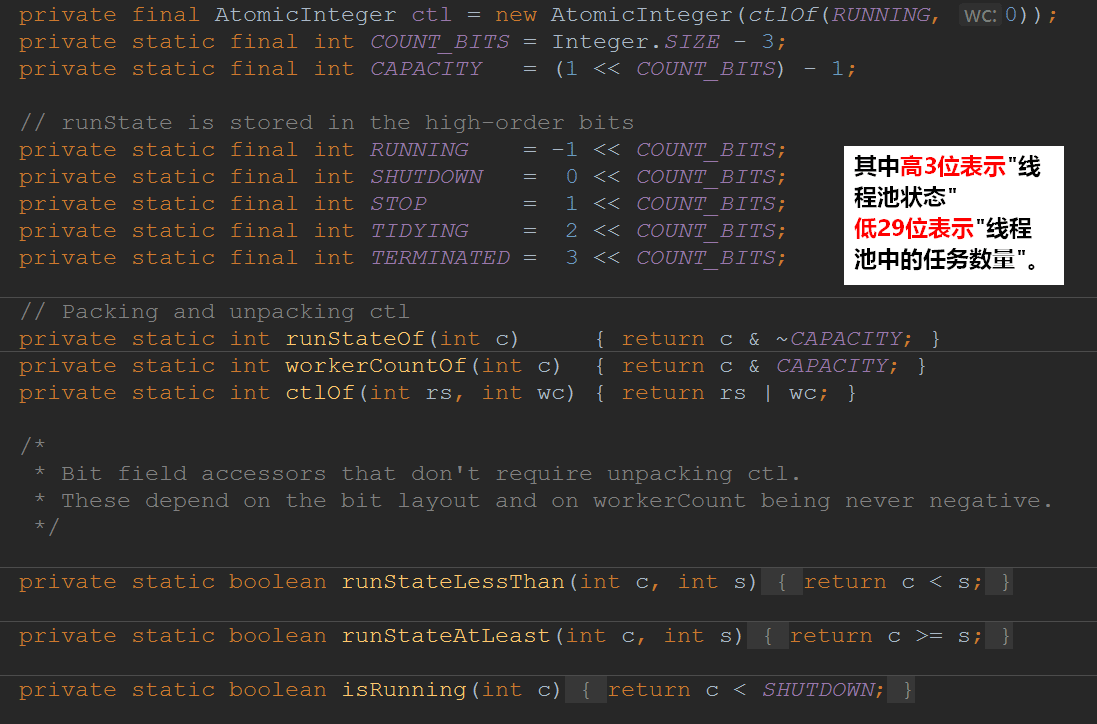
Ref: 线程池你真不来了解一下吗? - Java3y - 博客园
線程池各個狀態切換框架圖:

Ref: Java多线程线程池(4)–线程池的五种状态_Runner的博客-CSDN博客
線程池的狀態:
RUNNING: 线程池能够接受新任务,以及对新添加的任务进行处理。SHUTDOWN: 线程池不可以接受新任务,但是可以对已添加的任务进行处理。STOP: 线程池不接收新任务,不处理已添加的任务,并且会中断正在处理的任务。TIDYING: 当所有的任务已终止,ctl记录的”任务数量”为0,线程池会变为TIDYING状态。当线程池变为TIDYING状态时,会执行钩子函数terminated()。terminated()在ThreadPoolExecutor类中是空的,若用户想在线程池变为TIDYING时,进行相应的处理;可以通过重载terminated()函数来实现。TERMINATED: 线程池彻底终止的状态。
整理成表格:
| 狀態 | 高三位 | 未添加的任務 | 工作列隊workers中的任務 | 阻塞列隊worksQueue中的任務 |
|---|---|---|---|---|
| RUNNING | 111 | 添加 | 繼續處理 | 繼續處理 |
| SHUTDOWN | 000 | 不添加 | 繼續處理 | 繼續處理 |
| STOP | 001 | 不添加 | 嘗試中斷 | 不處理 |
| TIDYING | 010 | 不添加 | 處理完了 |
如果由SHUTDOWN -> TIDYING,那就是處理完了 如果由STOP -> TIDYING,那就是不處理 |
| TERMINATED | 011 | 同TIDYING | 同TIDYING | 同TIDYING |
Ref: 线程池你真不来了解一下吗? - Java3y - 博客园
線程池方法介紹
execute
execute()方法實際上是Executor中聲明的方法,在ThreadPoolExecutor進行了具體的實現,這個方法是ThreadPoolExecutor的核心方法,
通過這個方法可以向線程池提交一個任務,交由線程池去執行。
慣例來看JDK:
/**
* Executes the given task sometime in the future. The task
* may execute in a new thread or in an existing pooled thread.
*
* If the task cannot be submitted for execution, either because this
* executor has been shutdown or because its capacity has been reached,
* the task is handled by the current {@code RejectedExecutionHandler}.
*
* @param command the task to execute
* @throws RejectedExecutionException at discretion of
* {@code RejectedExecutionHandler}, if the task
* cannot be accepted for execution
* @throws NullPointerException if {@code command} is null
*/
public void execute(Runnable command) {
if (command == null)
throw new NullPointerException();
/*
* Proceed in 3 steps:
*
* 1. If fewer than corePoolSize threads are running, try to
* start a new thread with the given command as its first
* task. The call to addWorker atomically checks runState and
* workerCount, and so prevents false alarms that would add
* threads when it shouldn't, by returning false.
*
* 2. If a task can be successfully queued, then we still need
* to double-check whether we should have added a thread
* (because existing ones died since last checking) or that
* the pool shut down since entry into this method. So we
* recheck state and if necessary roll back the enqueuing if
* stopped, or start a new thread if there are none.
*
* 3. If we cannot queue task, then we try to add a new
* thread. If it fails, we know we are shut down or saturated
* and so reject the task.
*/
int c = ctl.get();
if (workerCountOf(c) < corePoolSize) {
if (addWorker(command, true))
return;
c = ctl.get();
}
if (isRunning(c) && workQueue.offer(command)) {
int recheck = ctl.get();
if (! isRunning(recheck) && remove(command))
reject(command);
else if (workerCountOf(recheck) == 0)
addWorker(null, false);
}
else if (!addWorker(command, false))
reject(command);
}
這個方法中的重點都在方法裡的注釋中:
/*
* Proceed in 3 steps:
*
* 1. If fewer than corePoolSize threads are running, try to
* start a new thread with the given command as its first
* task. The call to addWorker atomically checks runState and
* workerCount, and so prevents false alarms that would add
* threads when it shouldn't, by returning false.
*
* 2. If a task can be successfully queued, then we still need
* to double-check whether we should have added a thread
* (because existing ones died since last checking) or that
* the pool shut down since entry into this method. So we
* recheck state and if necessary roll back the enqueuing if
* stopped, or start a new thread if there are none.
*
* 3. If we cannot queue task, then we try to add a new
* thread. If it fails, we know we are shut down or saturated
* and so reject the task.
*/
就不翻譯說明了,對照上面的資訊,思考後理解。
submit
submit()方法是在ExecutorService中聲明的方法,在AbstractExecutorService就已經有了具體的實現,在ThreadPoolExecutor中並沒有對其進行重寫。
這個方法也是用來向線程池提交任務的,但是它和execute()方法不同,它能夠返回任務執行的結果,
去看submit()方法的實現,會發現它實際上還是調用execute()方法,只不過它利用了Future來獲取任務執行結果。
/**
* @throws RejectedExecutionException {@inheritDoc}
* @throws NullPointerException {@inheritDoc}
*/
public Future<?> submit(Runnable task) {
if (task == null) throw new NullPointerException();
RunnableFuture<Void> ftask = newTaskFor(task, null);
execute(ftask);
return ftask;
}
/**
* @throws RejectedExecutionException {@inheritDoc}
* @throws NullPointerException {@inheritDoc}
*/
public <T> Future<T> submit(Runnable task, T result) {
if (task == null) throw new NullPointerException();
RunnableFuture<T> ftask = newTaskFor(task, result);
execute(ftask);
return ftask;
}
/**
* @throws RejectedExecutionException {@inheritDoc}
* @throws NullPointerException {@inheritDoc}
*/
public <T> Future<T> submit(Callable<T> task) {
if (task == null) throw new NullPointerException();
RunnableFuture<T> ftask = newTaskFor(task);
execute(ftask);
return ftask;
}
shutdown & shutdownNow
引用自:线程池你真不来了解一下吗? - Java3y - 博客园
【shutdown()】
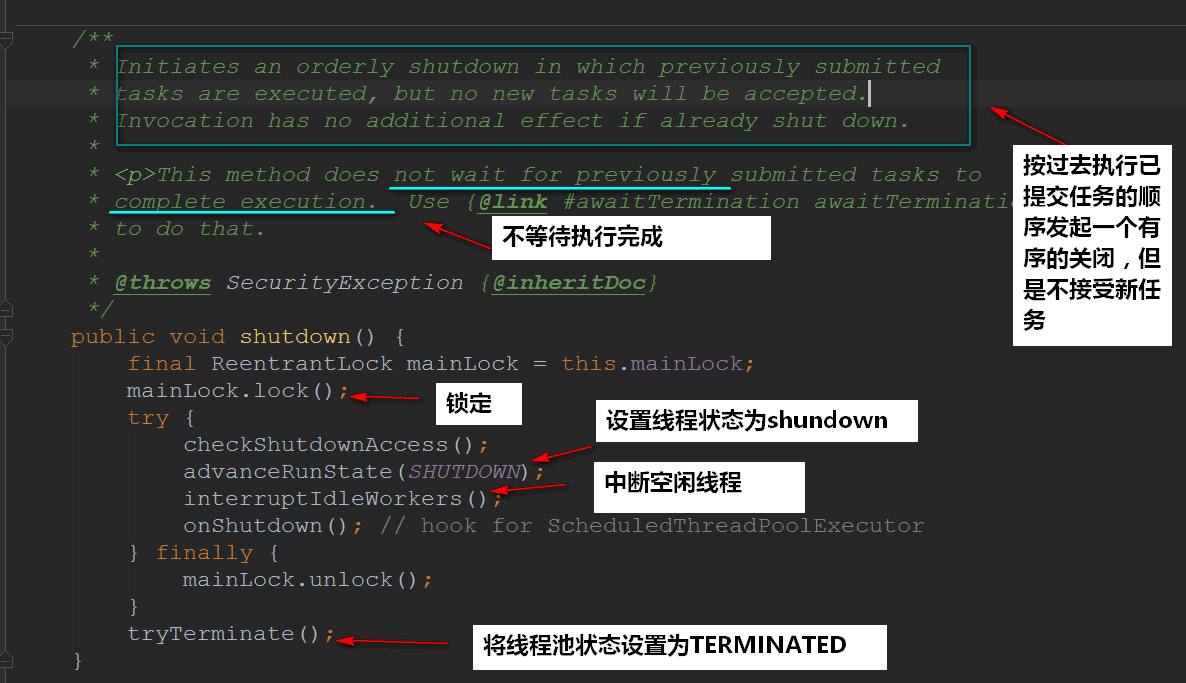
【shutdownNow()】
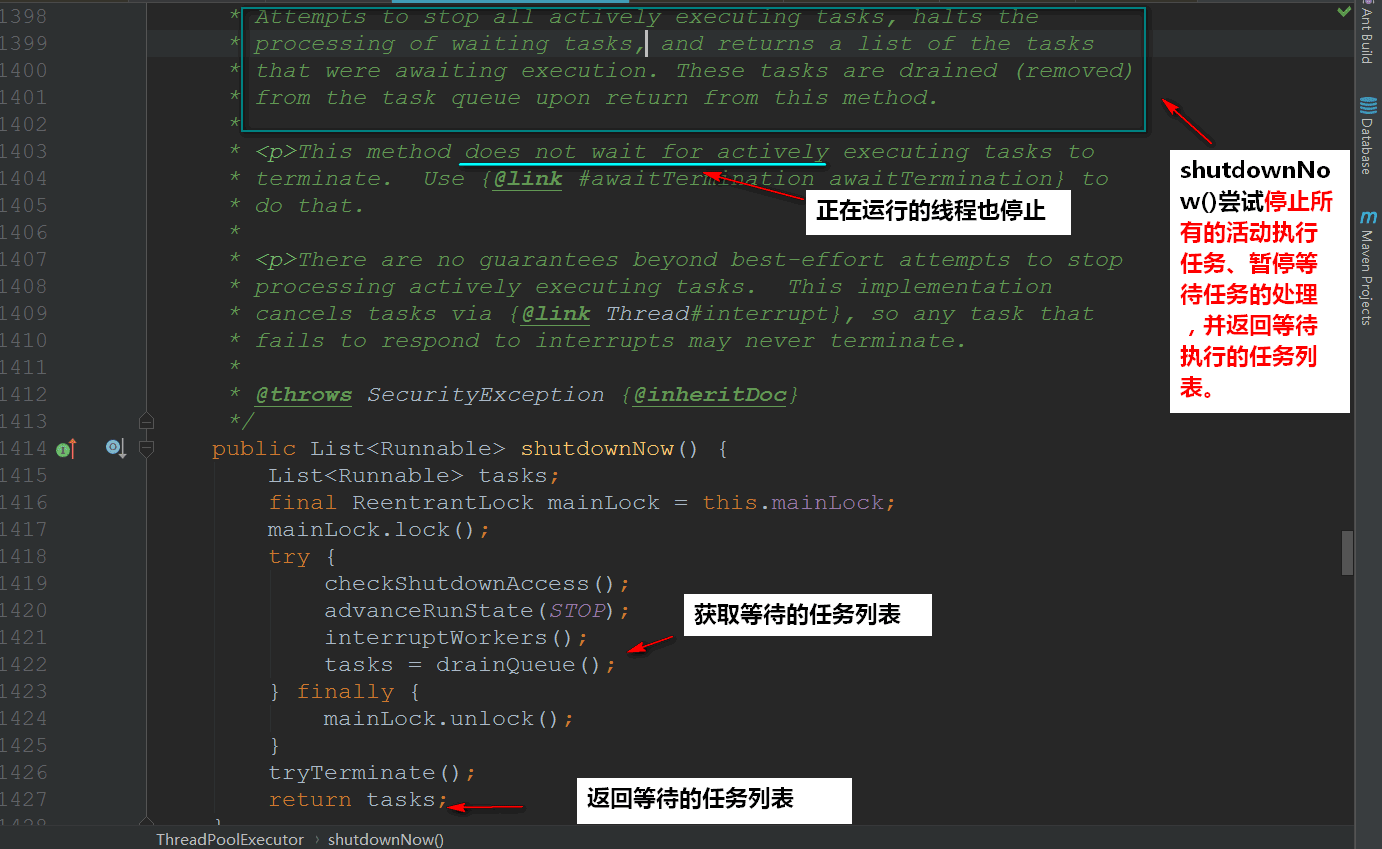
区别:
- 调用
shutdown()后,线程池状态立刻变为SHUTDOWN,而调用shutdownNow(),线程池状态立刻变为STOP。shutdown()等待任务执行完才中断线程,而shutdownNow()不等任务执行完就中断了线程。
Executors vs ThreadPoolExecutor
這裡先簡單的說明使用兩者創建線程池有啥區別:
- Executors: 簡便的線程池工廠方法
- ThreadPoolExecutor: 較複雜,但可以細節調控
Oracle官方建議使用Executors創建線程池,但《阿里巴巴Java开发手册》卻建議使用ThreadPoolExecutor創建線程池,差別在於可以更細節調控效率效能。
Ref:
- ThreadPoolExecutor (Java Platform SE 8 )
- Java Thread Pool - ThreadPoolExecutor Example - HowToDoInJava
- JUC学习笔记–从阿里Java开发手册学习线程池的正确创建方法 - JavaNoob - 博客园